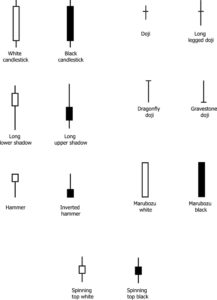For centuries, Japanese candlestick charts have been used to develop forecasts for financial investment. In reading and interpreting the information conveyed by those blocky little candles and their wicks, we can understand a stock’s movements and predict its future. Risk is unavoidable, but you can increase your confidence and your success rate by studying patterns, developing forecasts, waiting for confirmation, and remaining calm and vigilant. Learning how to trade Japanese candlesticks requires practice and patience, but it’s well worth the effort.
How to Trade Japanese Candlesticks
30-Day Trial | Learn to Trade From Home
1. LEARN. First, you will need to learn how Japanese candlesticks work. Study their characteristics so that you thoroughly understand the mechanics of their formation. You should be able to decipher opening prices, closing prices, highs, lows, pauses, and jumps. These are the basics:
Bullish candles are green or white, while bearish candles are red or black.
Top wicks represent high prices, and bottom wicks represent low prices.
The top of a bullish candle’s body indicates the close and the bottom indicates the open.
The top of a bearish candle’s body indicates the open and the bottom indicates the close.
This may seem like a lot of mumbo jumbo now, but with a little practice, you’ll soon be fluent in the languages of Japanese candlesticks.
2. STUDY. Next, study important patterns and signals. You can start with the basics, like Doji, the Harami, the Hammer, Kicking patterns, and Engulfing patterns. Then, move on to less common patterns, like the Rising Three and Falling Three Methods. Learn how to identify these patterns, interpret them, and confirm their presence.
3. CHART. After that, find a charting program that you feel comfortable with, whether that’s TC 2000 (our personal favorite) or a platform like TOS, Fidelity, Scottrade, or Schwab. The choice is yours. Determine your needs, research potential programs, and select your ideal product.
4. ENGAGE. Then, join an online trading chat room, where you can share ideas, receive encouragement, and engage in problem-solving discussions. This will be especially beneficial if you’re new to Japanese candlestick trading. Hit & Run Candlesticks is an ideal environment for new traders, because the community is encouraging and the other members truly want to help you succeed. Plus, the blog includes daily swing trading ideas for inspiration.
5. TRADE. Finally, it’s time to get started! Swing trading is not for the faint of heart, so you must be willing to make mistakes and risk your money. Follow the market and when you anticipate a price action (and can confirm that it’s on the horizon), make your move! Soon, you’ll be reading the stories told by a sequence of candlesticks with ease, deftly forecasting reversals, and reacting skillfully once you have confirmation.
– – – – –
Japanese candlesticks can be used in conjunction with traditional forms of stock analysis, such as bar charts and line graphs. They add another dimension to our understanding of the stock market’s current mood, providing red flags to warn you of impending doom and tip-offs to guide you toward success. With persistence and a bit of research, you’ll soon be past the learning curve and on your way toward a successful future in candlestick trading. Good luck!




